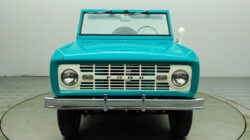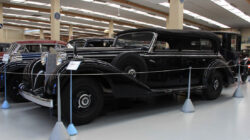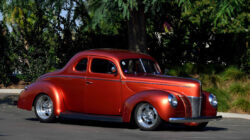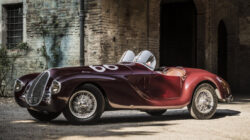1940 Mercury convertible was not only one of the best-looking cars on the road, but it was also the most affordable way to get into the Mercury brand. With styling very similar to other convertibles in its class.
Including Buick and Lincoln, the 1940 Mercury Convertible found itself on many a driveway that year, bringing smiles to its owners and passersby alike as they gazed upon this sleek ride.
The Mercury brand originated in 1939 as the only Ford-branded vehicle sold by Mercury dealers. The following year, it offered a variety of sedans, coupes, and convertibles, including the 1940 mercury convertible coupe shown here.
With its straight-six engine and stylish, sporty design, the 1940 Mercury convertible came in three models: the Marquis, with seating for five and available with either standard or Super trim, the Sport Sedan Coupe, and the Sport Phaeton, which seated four, and could only be had in Deluxe trim.
The 1940 Mercury convertible sedan was the perfect ride for stylish and sporty drivers of the era. The Mercury line came in 11 varieties, but the convertible versions were popular among celebrities, including actors Rita Hayworth and Betty Grable.
Today, these convertibles are highly sought after by collectors and are easy to find at auctions and online classifieds sites.
If you’re interested in this classic car but aren’t sure where to start, here’s everything you need to know about buying a 1940 Mercury Convertible (and how to do it without overpaying).
History of The 1940 Mercury Convertible

Founded in 1938, Mercury was America’s compact luxury automobile line. The brand name was derived from Roman mythology, Mercury is often depicted as a swift messenger, traveling swiftly across heaven to deliver messages to mortals.
The namesake is fitting for a car company that quickly gained popularity for being quick, sleek, and sophisticated.
In 1940, Ford debuted its second-generation Mercury models featuring new body styles such as 2-door coupe and 4-door sedans.
The rest of the year’s lineup remained mostly unchanged with a few added models such as convertible coupes.
Big Changes
For its sophomore year, Mercury offered a variety of sedans, coupes, and convertibles. For those who wanted something different from what Ford was offering for 1939, Mercury was a great option.
The 1940 Big-Eight convertible coupe provided that something different with plenty of style and sportiness as well. This car became so popular that it was often referred to as a good-looking car.
Dizzying Diversity
The 1940 Mercury came in a dizzying array of configurations, from sedans to coupes to convertibles, to say nothing of all of its colors.
This made it easier for buyers to find something that suited their tastes, however, it also meant that any individual shopper had an enormous amount of variety to pick through before selecting a final car.
While one buyer may have been drawn by a fastback coupe, another might have opted for a 4-door sedan.
In spite of all its options, though, some qualities remained constant across most 1940 Mercurys. The majority were painted blue or black and most could be had with either 6-cylinder or 8-cylinder engines.
Mercury Engines
One of three engine options for 1940 Mercurys was a 225 cubic-inch Light Eight engine, producing 100 horsepower. Another option was a 239 cubic-inch Thunderbolt engine, with 130 horsepower.
Still another option was a 292 cubic-inch V8, producing 120 horsepower. Each engine could be mated to either a three-speed manual transmission or an optional automatic unit which became available in 1940.
All four wheelbases offered both front and rear independent suspension as standard equipment, with semi-elliptic leaf springs in front and semi-trailing arms in back on all but sixes, which came with transverse leaves all around.
No other vehicles produced by any manufacturer could match these features and standards at that time! Truly revolutionary stuff!
Style and Luxury
The 1940 mercury convertible sedan was a stylish vehicle, on par with its competitors from Cadillac Series 62, Packard, and Lincoln. It featured a stylish grill that gave it a sleek look. The tail lights also lit up to improve visibility at night.
It offered 4 seating options for its customers: a 2-door sedan, 2-door hardtop coupe, 4-door hardtop sedan, or a convertible body style with either 4 or 6 seats.
Two engines were available including a high compression V8 of 234 cubic inches for $1,945 or one with 186 cubic inches for $1,795.
New Technology
The 1940 Mercury convertible marked a revolutionary time in automobile history for a number of reasons. It was 1940, after all, the eve of World War II.
This meant that new technology focused on military operations, not to mention women taking over men’s jobs while they were away fighting.
We’ve come quite a long way in terms of female empowerment since then (thanks, Rosie!), but some facets remain constant.
One thing is for sure, you’ll have no trouble getting around town in style with our 1940 Mercury Convertible in tow!
Legendary Performance
When it came to cars, 1940 was a memorable year. The Mercury Convertible was only in its second year of production, which means now is a great time to learn more about its stylish performance.
During World War II, many people would turn to cars for fast getaways and family fun; so let’s take a look at some of their favorites! Let’s start with the sedan.
With its attractive styling (including decorative chrome strips along each side) and roomy design, drivers would be drawn to it immediately.
When you flip open that trunk (equipped with an overhead light) you’ll discover plenty of space for your belongings, up to 9 cubic feet of storage space!
Elegant Exteriors
In 1940, many Americans wanted four-door cars. In response, Ford offered a four-door version of its popular Ford sedan.
The same thing happened at Lincoln, it introduced a six-window coupe that included a four-door option. However, not everyone wanted these practical vehicles, some people just wanted something sportier.
That’s where Mercury came in; for 1940, Ford made sure that its midlevel brand had options for everyone in its lineup.
For those who preferred something sleek or sporty, there was a two-door convertible or coupe available to them instead of just sedans and coupes with extra doors added on.
Read also: The Best Classic American Cars 40s and 50s
Solid Foundations
Founded in 1939 by Edsel Ford, Mercury was intended to be a lower-priced brand than Ford. The original lineup included sedans, coupes, convertibles, trucks, and a roadster with modern styling at a very affordable price.
With few brands able to compete with such style at such an affordable price (the closest competitor being Lincoln), sales were good right out of the gate.
Just two years after its founding, World War II halted production as all automakers shifted their focus toward producing vehicles for military use.
Decades of Success
Since its debut in 1939, there has been an outpouring of interest for our new Mercury models. During its second year, 1940, it offered a wider range of vehicles ranging from convertibles to sedans.
From their unique design to comfortable interior and smooth ride, people have fallen in love with these classic vehicles. Let’s take a look at some of them!
1940 Mercury Convertible – For its sophomore year, Mercury offered a variety of sedans, coupes, and convertibles.
With an independent front suspension that allowed for high-speed stability coupled with a 116-inch wheelbase.
Combined with plush leather seats created by Herman Knapper’s division, it was no wonder why so many people fell in love with it.
Frequently Asked Questions (FAQ)
How much is a 1940 Mercury car worth?
The value of a 1940 Mercury car can vary considerably. One factor that will affect a 1940 Mercury’s worth is considered to be a vintage or antique car.
If a 1940 Mercury is labeled as an antique, then it could command more money than one that isn’t. Another thing to consider is how many were produced in these years.
The fewer car of any given make or model that were produced, the more valuable those cars are likely to be.
Due to their rarity, not just any 1940 Mercury 4-door convertible will command top dollar at the auction either; certain models, like convertibles and four-door sedans, will cost more than coupes.
How many 1940 Mercury coupes were made?
40,000 1940-model Merciers were made, including 704 convertibles. This makes 1940 one of just two model years that fewer than 1,000 convertibles were produced.
Mercury closed its convertible production line in 1941 to concentrate on manufacturing military vehicles for World War II.
Most of these 40,000 models came with a 4-door body style. The exception is 374 1940 Deluxes that came with 2-door bodies.
What years did Mercury have suicide doors?
The Mercury division of Ford Motor Company was founded in 1939 as a 1939 model, but all 1940 models went into production late in 1939.
Some sources say that early 1952 Mercurys have a styling cue that looks like suicide doors but is actually hidden rear quarter windows.
Confusingly, some sources call those hidden rear quarter windows suicide doors. If you’re going to buy an old car, don’t pay any attention to it size or weight unless you want to drive it every day.
Conclusion
During its sophomore year, Mercury built upon a solid foundation by offering many body styles to suit every taste.
As it heads into its third year, there’s no doubt that by adding so many new body styles it will continue to build on its success.
The 1940 Mercury convertible sedan was one of those offerings that definitely broadened horizons and caught drivers’ attention. It’s available in 2-door versions but also as a 4-door version with larger trunk space.
This vehicle could make for an excellent commuter car or even a family vehicle with four doors and seating for 5 people comfortably including a spacious back seat area for two passengers comfortably.






